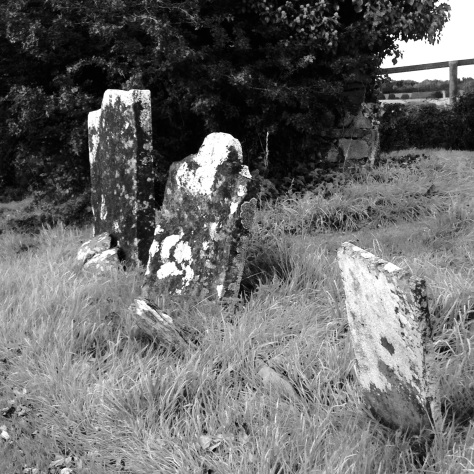Sunday 12th October 2014
After years of driving by a sign ‘Reilig’ and thinking “that must be an old closed graveyard down that boreen, I must check it out some time”, I finally decided to go and see it. It was only a few kilometers out the road and I hoped it would be a good candidate for my first post to the blog.
As I opened the gate, I knew it wasn’t a good sign to see gleaming marble stones and fresh flowers amongst some much older ones….this was a well cared for graveyard and obviously in use so it didn’t fit the criteria I had set out i.e. must be unused and closed. Feeling a bit deflated I took out the ordnance survey map and looked for other possible sites in the vicinity and headed off to find them. I tried to find three more graveyards but failed, but I did get to see remote parts of Kildare I didn’t know existed!
About ready to throw in the towel but I took one last look at the map and spotted a graveyard marked at Pollardstown, near the Curragh. I found it easily enough, my map reading skills had improved throughout the afternoon!
In the grounds along with the graveyard, is the remains of an old stone church, only the two gable ends are standing and they are being held together by the trees and vegetation. But at least the grass is being kept cut, pobably by the council so it was easy to walk around. I think the church dates back to the 12th century thought there is very little known about it according to online records. The headstones are laid out all around the church however many have fallen or are leaning heavily, and very few inscriptions are clearly visible as the lichen has taken over.
There were two headstones which caught my eye, one erected by a James Cluxton in memory of Bailey Cluxton and some other members of his family, including his three infant children. I noticed that there were no female members of the family mentioned e.g. wife. With the range of years from 1800 to 1920, I was hopeful that I might find out a little bit more in the census records around those years but couldn’t find him. However I was able to find some of the later names listed in the 1911 census, they appeared to have been from Calverstown (near Kilcullen). From a family of 13, at least 3 of the sons were working as pawnbroker assistants in Dublin, which I thought was unusual.
The other headstone which I found interesting because of the shape and the style of language used for the inscription “Here lyeth the body of Mauri O’ Duin who departed this life November the 28th in the year of our Lord God 1758 and in the 65th year…” The stone is in pretty good condition for it’s age and it sits as part of three which are directly beside backed onto one one of the end walls of the church, it looks like a later stone next to it has been cleaned up but I’ve been unable to find out anything further on this as the online records for this period aren’t great.
So that’s it so far for my first attempt, I’m still hopeful I will find out a bit more about these two families at a later date and if I do, I will update this post.
Mary







Here’s some information about the Cluxton gravestone. Bailey and his father, also named James, were assaulted in a pub by two policemen in October 1836, apparently for political reasons. They both appear as freeholders in the 1825 Tithe Applotments for Kilcullen. In fact James Cluxton was the Tax Commissioner for Kilcullen, and his signature appears many times in the Tithe Applotment documents. James was evidently very wealthy. He is surely a descendant of the merchants William, Robert and John Clugston who were merchants in Belfast from the 1630’s. They originally came from Wigtownshire, Scotland. One of the grandchildren was Sovereign of Belfast in 1730. Six descendants held land at Lough Ross in 1753, but then dispersed. It seems that James inherited a large chunk of the family fortune.
After that, the family’s luck seems to have changed.
A “Railey Cluxton” of Kildare, was imprisoned for manslaughter in 1850, age 37. This is likely to be the same Bailey Cluxton on this tombstone. He may have died in prison.
Finally, in 1876, a James Cluxton of Killcullen Bridge was in bankruptcy court. His legitimacy was challenged because his parents, Bailey Cluxton and Anne Kearney, were married in 1842 by Rev Mr. Maguire, described as a “couple beggar”, not legally able to issue marriage licenses. Apparently he died shortly after bankruptcy was finalized — perhaps not from natural causes.
So it is quite a story.
LikeLiked by 1 person
Thanks for that Rob!
LikeLike